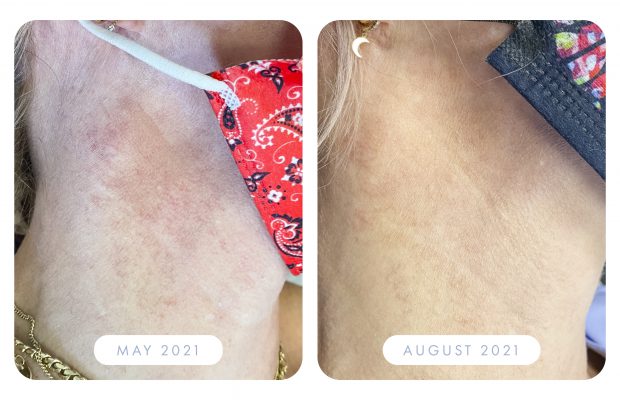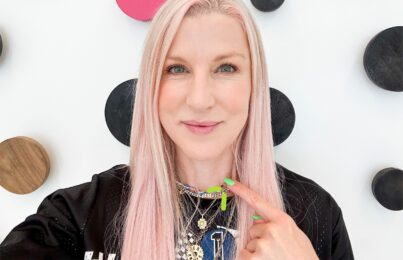I was about 45 when I first noticed some redness on my neck, accompanied by patches of brown hyperpigmentation. Having been an esthetician since my early 20s, I immediately recognized the discoloration on my neck as a harmless (but annoying) condition called Poikiloderma. It’s sometimes also referred to as “Poikiloderma of Civatte.” But in 2020, when I was 51, was when I really noticed it became a lot more prominent.
The reason it became more noticeable was due to my increased activity outdoors at the start of the pandemic. Gyms were closed so I took all my workouts outside. Between cycling, running, and hiking, I spent enough time in the sun and heat that the red and brown patches on my neck really fired up and it stayed consistently visible until recently when I decided it was time to do something about it.
In this post, I’ll explain how and why poikiloderma develops, how I manage it at home, and which professional treatments gave me the best results.
What is Poikiloderma?
Poikiloderma is a harmless but fairly common condition that causes skin discoloration and thinning. As you can see in my photos above, it’s a combination of red and brown pigment that’s found on both sides of the neck and sometimes the center of the chest. Affected areas can also experience hypopigmentation, which is an absence of pigment altogether. All this creates a blotchy and generally discolored look.
Redness on the neck associated with poikiloderma is caused by vascular damage. It’s common to have little clusters of dilated or broken capillaries, which is what makes the skin look so red.
Brown patches associated with poikiloderma are hyperpigmentation caused by an excess production of melanin. This is no different than hyperpigmentation brought on by conditions such as melasma or even just summer sun spots, but the combination of brown and red discoloration makes poikiloderma a little more complicated to address.
What Causes It?
The cause of poikiloderma isn’t entirely clear. Since it’s a group of symptoms rather than an actual disease, there are multiple factors that can contribute to this condition.
The main trigger, however, seems to be sun damage. Poikiloderma is sometimes simply referred to as “sun aging.” Other possible factors include genetics, certain diseases, or hormonal changes (especially in women).
Since poikiloderma mostly appears on the sides of the neck, I used to hear the theory that it was brought on by a reaction to perfume or cologne being spritzed onto this delicate skin and how it might interact with the sun. This has since been debunked, but I still avoid using perfumes or anything else sensitizing on these areas.
Who Gets It?
Poikiloderma can occur in both men and women, and you’re most likely to develop it after the age of 40. It also occurs mostly in people with fair to medium skin tones. “Risk factors” include a history of excessive sun exposure, having a family member with poikiloderma, and having gone through menopause.
However, why exactly I developed poikiloderma has always been a mystery to me. I’m just not someone who’s gotten a lot of sun damage in my life by any stretch. Because I became an esthetician so early in my life (age 19!), I have never been a sun worshipper at all. That said, I do have three of the risk factors mentioned: I’m over 40, I’m currently going through menopause, and I have a fair skin tone. I guess because of that, the little sun exposure I did get was enough to trigger it??? Who really knows.
How I Manage My Pokilioderma
Pigmentation issues can be one of the most frustrating types of skin concern to deal with. This is because they can usually only be managed, not eradicated, and it takes constant dedication to keep discoloration at bay. Add to that the vascular damage caused by poikiloderma, and you’ve got a condition that requires a lot of dedication to manage.
I was able to fade the redness and the brown patches on my neck through a combination of a strict at-home skincare routine, lifestyle adjustments, and regular professional treatments.
At-Home Management
I always want to set realistic expectations, so I think it’s important to note that topical skincare can only take you so far with a condition like poikiloderma. Once it’s set in, you’ll only see a dramatic improvement from professional treatments. That said, what you do at home every day still has a big impact over time. Keep in mind that a lot of it will be about prevention— topical products and good habits can keep poikiloderma from getting worse (and are important for maintenance after you’ve gotten professional treatments done).
Even if you don’t go the professional route, I recommend implementing a few of the following suggestions to strengthen and protect the skin on your neck.
1. Wearing SPF and Avoiding Excessive Sun Exposure
Diligently wearing sunscreen and minimizing my sun exposure are the main ways I keep the discoloration on my neck at bay. As I already mentioned, sun damage is thought to be the biggest trigger for poikiloderma, so this is the most important thing you can do.
Poikiloderma occurs on the sides of the neck, and this is actually one of the most overlooked areas for sunscreen application. The skin under your chin is often somewhat protected by the shadow from your face, so it’s no surprise sun damage develops mostly on the sides. Learn how to properly apply sunscreen to the face and neck (hint: most people are doing it wrong).
Aside from relying solely on sunscreen, I cover up with sun-protective clothing when I can and try to stay out of direct sun during peak daylight hours. Listen, I love being outdoors, and I’m not going to stop living my life just because I’m worried about my poikiloderma. But making small lifestyle adjustments to avoid sun exposure here and there has a real impact over time.
2. Avoiding Heat When Possible
Sun exposure isn’t the only thing that can exacerbate redness and hyperpigmentation—heat is a big driver as well. Heat causes capillaries to expand and dilate, which increases blood flow and flushing to the skin. It also activates the already over-active pigment cells responsible for hyperpigmentation. This is one reason summer sun spots are so hard to control.
3. Faithfully Using a Vitamin C Serum
In addition to wearing sunscreen every day, I faithfully apply a vitamin C serum to my neck. I use the Vitamin C&E Treatment because it uses a no-sting form of vitamin C that’s effective, yet gentle enough for the delicate neck area. Not only does this improve sun protection, but it also helps to suppress fussy pigment cells responsible for the brown patches associated with poikiloderma.
4. Applying a Gentle Retinol
A few nights a week, I’ll use this gentle retinol serum on my neck to improve and even out my skin tone. It helps speed up skin cell turnover so old, hyperpigmented cells rise to the surface more quickly. Once they’ve cycled to the top layer of my skin, I can easily slough them off with exfoliation.
Retinol also helps build collagen, which is important since poikiloderma weakens the skin over time.
5. Exfoliating Regularly
I usually recommend a combination of chemical and physical exfoliation to fade pigmentation. The skin on the neck, however, is very sensitive, and I personally can’t handle exfoliating acids in this area as I get irritation. Instead, I stick to using this gentle facial scrub with rounded beads that won’t scratch the skin. Physical exfoliation is essential for fading pigmentation because it actually lifts expired pigment cells up and away to reveal brighter skin underneath.
If you’re someone who can tolerate occasional chemical exfoliation on your neck, use something like the Ultra Gentle Smoothing Serum. To avoid irritation, I recommend doing it on a night when you’re not using retinol serum or a physical scrub.
6. Using Neck Cream Every Night
Finally, I use the Intensive Firming Neck Creme nightly. It soothes skin and delivers antioxidants through plant extracts, and it also includes peptides to firm the skin.
7. Taking Vitamin C Supplements With Bioflavonoids
Bioflavonoids can help strengthen fragile blood vessels and prevent bruising. I take 1,000 mg of vitamin C with bioflavonoids every day as a preventative measure to avoid broken capillaries. This won’t get rid of poikiloderma or prevent the redness from appearing, but it’s all part of keeping the skin and capillaries strong to avoid further damage.
Here are six other tips to avoid broken capillaries.
Professional Treatments for Managing Poikiloderma
While a dedicated skincare routine and smart lifestyle choices are key components of managing poikiloderma, truly fading it requires some professional intervention. I started getting both laser and light therapy last year, and it’s made a huge difference in the amount of brown patches and redness on my neck. I get these treatments done by an esthetician at my dermatologist’s office.
Because of the combination of redness and hyperpigmentation, poikiloderma has to be addressed with two different treatments.
Vbeam Laser for Redness
The first treatment I’ve been getting is called Vbeam. Vbeam is a type of pulsed-dye laser that’s used to address redness and broken capillaries. It works by producing an intense burst of light that destroys damaged blood vessels without hurting the surrounding tissue.
Vbeam is a little uncomfortable, but not painful. It sort of feels like bursts of very cold air being pushed across my face.
IPL for Brown Spots
The second treatment is a type of light therapy called Intense Pulsed Light (IPL), sometimes also referred to as photofacial. It targets hyperpigmentation by breaking down bundles of melanin in the skin into tiny pieces so they can rise to the surface and be sloughed off.
IPL is definitely more uncomfortable than Vbeam, but again, I wouldn’t go so far as to say it’s painful. This one feels more like little rubber bands being snapped against the skin.
How Often to Get Treatments
I’ve been getting both Vbeam and IPL once a month since I started. I get both done during the same session, starting with the Vbeam.
As you can see in the photos above (which were taken after only four treatments!), the results have been great and I’m very happy with them.
How often you choose to go in is ultimately up to you. The dermatologist at my office recommended 3-6 initial sessions of both Vbeam and IPL to fade the redness and pigmentation from poikiloderma. I’ve obviously chosen to go in very regularly since then, but I can appreciate that not everyone is up for this. After the initial sessions, you may find you’re happy and can maintain results by following the at-home tips I outlined earlier. Then, you can go in once or twice a year for maintenance depending on how visible it is and how much it’s bothering you.
The other option is going in for just one or the other. For example, now that summer is coming up, the heat might bring out more of the brown so I may go in for just a session of IPL. Or, if you’re someone who’s affected more by the redness, you can opt for just Vbeam.
Bottom Line
Although no one knows exactly what causes poikiloderma in certain individuals, sun exposure seems to be the main trigger. The combination of brown hyperpigmentation and redness from vascular damage can be tricky to address. It requires a consistent at-home skincare routine, lifestyle changes like avoiding sun exposure, and professional treatments to fade discoloration. I’ve had a lot of success with a combination of Vbeam laser for redness and IPL for brown spots.
Finally, remember that, like melasma, poikiloderma is something that has to be continually managed and can’t be completely eradicated. No fun!
Next, learn how to repair sun damage on the neck and chest.
Celebrity Esthetician & Skincare Expert
As an esthetician trained in cosmetic chemistry, Renée Rouleau has spent 30 years researching skin, educating her audience, and building an award-winning line of products. Her hands-on experience as an esthetician and trusted skin care expert has created a real-world solution — products that are formulated for nine different types of skin so your face will get exactly what it needs to look and feel its best. Trusted by celebrities, editors, bloggers, and skincare obsessives around the globe, her vast real-world knowledge and constant research are why Marie Claire calls her “the most passionate skin practitioner we know.”



